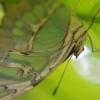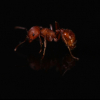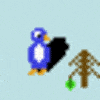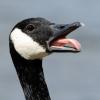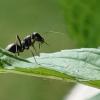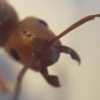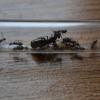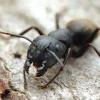Scientific Name: Camponotus pennsylvanicus
Common Name: Black carpenter ant, common carpenter ant
Distribution: Eastern and Central Canada and United States. Common in the Eastern and Central United States and the lower regions of Canada.
Queen size: 15-18 mm
Worker size: 6-14 mm, polymorphic
Natural Habitat: Normally found in trees, logs and occasionally houses.
Circadian Activity: Primarily nocturnal, however, will occasionally forage in the daytime.
Mating Flight: Usually the first warm afternoon in Spring. Will fly as early as March and as late as July.
Queen Founding Method: Fully Claustral
Monogyne or Polygyne: Strictly Monogyne
Average time from egg to worker: Egg to larva = 20-30 days; larva to pupa = 10-15 days; Pupa to worker = 18-25 days.
This species grows very slowly. In the beginning it only takes 1.5-2 months for nanitics, but it takes 2+ months in a normal colony. The average time from egg to worker is highly dependent on temperature. Time is highly dependent on temperature; a higher temperature will generally reduce the average time.
Recommended Temperature: 75-80°F (24-27°C)
It is a heat loving ant, so a heating cable is preferred. Hibernate them at roughly 46-55°F (8-13°C). Queens found in a warmer location might prefer more heat.
Recommended Humidity: Queens found in more desert locations may prefer a lower humidity. Queens found in more temperate locations prefer a higher humidity. Different stages of brood will be kept at different humidity levels.
Preferred Foods: Insects including crickets, termites, fruit flies, house flies, mealworms, spiders and grasshoppers/locusts. Sweets including sugar water, honey, syrup, and a variety of fruits.
This species also has a social stomach, so keep that in mind when it comes to foods. Here is a link to their preferred foods.
Hibernation Details: Requires hibernation. 3-5 months is recommended, depending on where the queen was collected.
Make sure they have access to water and sweets, as they may eat and drink during their hibernation. This species commonly falls over in hibernation and may appear dead until they wake.
Escape Barrier Methods: Fluon and talcum powder are effective at containing them. They are unable to climb upside down on olive oil. Vaseline or olive oil on a vertical surface will not contain them.
Difficulty rating: Great beginner species, but grows quite slowly. This species is good for someone with patience.
Bite and/or Sting rating: They can and will bite, and will likely dab formic acid on the bite. The pain will fade within a few minutes.
Special Care or Interesting Notes: As these are carpenter ants, they are able to chew through soft plastics, plaster, and sometimes a whole cotton ball. Also, these ants are especially susceptible to chemicals. They will require extra ventilation or airflow as they can produce a strong formic acid gas when startled or alarmed. These ants will often appear inactive during the day as they are primarily nocturnal. Colonies with less than 50 workers are far less active than colonies with more than 100 workers.
Additional Links:
http://www.antweb.or...=pennsylvanicus
http://www.antwiki.o..._pennsylvanicus
http://animaldiversi...pennsylvanicus/
http://bugguide.net/node/view/543
Information submitted by Ants4fun




